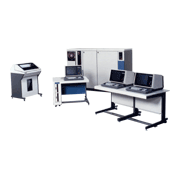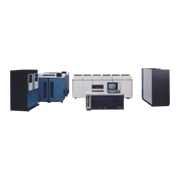In February 1979, one week after IBM announced its 4300 Series in January, NEC marketed the ACOS System 250 (hereafter referred to as the S250), as a competing model for the IBM 4331. In October of that year, NEC also marketed the System 350, 450 and 550 (hereafter referred to, respectively, as the S350, S450 and S550), which boasted the world's best cost-performance ratio at that time.
(1) S250
This was a small general-purpose computer, whose CPU was comprised of main memory and 5 distributed processors (an arithmetic processor, system control processor, service processor, magnetic disk processor and communications control processor). It employed N-channel MOS LSI with 3,300 gates for LSI logic, and 64K MOS RAM for memory, thereby reducing size, weight and floor space, and enabling use of commercial power sources. It had enhanced RAS design, and at the same time was capable of automatic operation. The main memory capacity was a maximum of 2 megabytes, and cycle time was 580 nanoseconds per 4 bytes.
Due to the use of LSI throughout, the S250 had a cost-performance ratio far better than IBM machines, and which made the S250 a best-seller, selling a total of 2,146 machines.
(2) S350, S450
These were mid-size general-purpose computers. They had complete compatibility with the previous S300 and S400, and employed microprocessors throughout the machine. The S450 had additional multiprocessor functionality and paging capability. It also had an input/output DAT mechanism, and was designed for compatibility with the S550. Reduced size and weight, and higher reliability, were achieved by using high performance LSI, such as 1,200 gate CML LSI for logic, and maximum 6,000 gate N-channel MOS for peripheral control, such as workstation control and CRT control.
(3) S550
This was a large general-purpose computer developed as the high-end model of the ACOS Series. To cope with the increasing diversity of processing in large systems, process concepts were extended for use with multiprocessors, and dispatching control, time slice control and input/output control were written into firmware. Overhead was reduced by using segmentation and paging concepts in input/output processing. The S550 was a completely symmetrical system where any CPU could simultaneously access any memory unit or input/output unit,and that with no bottlenecks. This machine achieved high-performance and high-reliability using the same LSI technology as the S350 and S450.
| S250 | S350 | S450 | S550 | |
|---|---|---|---|---|
| Announcement date | February 1979 | October 1979 | ||
| OS | ACOS-2 | ACOS-4 | ||
| Multiprocessor configuration | - | - | Possible | Possible |
| Main memory capacity | Max. 2MB | Max. 4MB | Max. 6MB | Max.8MB |
| Number of channels | Max. 12 | Max. 6 | Max. 16 | Max. 18 |
| Overall data transfer rate | Max. 4MB/s | Max. 6.5MB/s | Max. 11MB/s | Max. 16MB/s |
| CPU element | nMOS | Bipolar (air cooled) | ||
| Memory element | 64Kbit MOS RAM | |||



